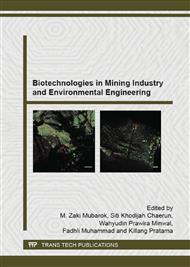p.226
p.230
p.234
p.238
p.243
p.247
p.251
p.255
p.259
Bioleaching of Complex Refractory Gold Ore Concentrate of China: Comparison of Shake Flask and Continuous Bioreactor
Abstract:
The laboratory tests of biooxidation and cyanidation were carried out by using samples of the complex refractory gold ore from China. The elemental composition was 16.8 % iron, 18.6 % sulfur, 4.88 % arsenic,2.30 % carbon and 3.49 % antimony. Gold is assayed at 46 g/t. The arsenic oxidation of 88.11 %,carbon removal rate of 32.34 % and antimony oxidation of 23.92 % over 16d was achieved in shake flasks in the presence of the mixed culture (HQ0211: Thiobacillus ferrooxidans Leptospirillum ferrooxidans and Thiobacillus thiooxidans). The continuous bioreactor tests resulted in greater dissolution rates for arsenic, carbon and antimony, which led to a greater extent of sulphide oxidation within a shorter period of time. The maximum oxidation of arsenic and antimony was 90.72 % and 40.09 % respectively and the removal rate of carbon is 63.48% after 8d in the continuous bioreactor tests. After bioleaching, the gold recovery of the oxidation residue was 98.02 % with the cyanidation method, which was showed the biological pretreatment was applicable to the complex refractory gold ore.
Info:
Periodical:
Pages:
243-246
Citation:
Online since:
November 2015
Authors:
Price:
Сopyright:
© 2015 Trans Tech Publications Ltd. All Rights Reserved
Share:
Citation:


